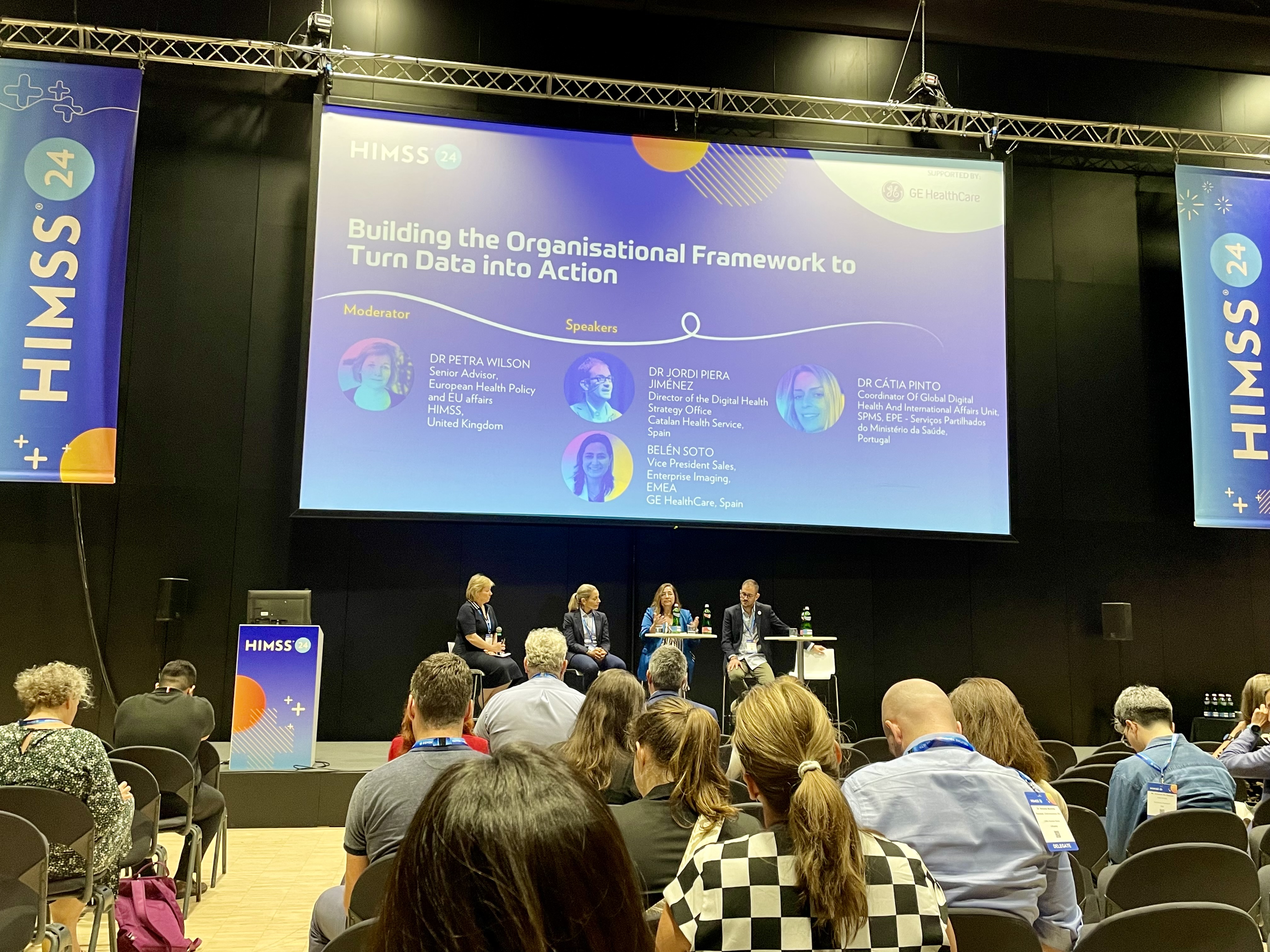This year’s Healthcare Information and Management Systems Society (HIMSS) European Health Conference and Exhibition, which took place from May 29-31 at the Roma Convention Centre in Rome, Italy, underlined the need for the wider adoption of innovative digital solutions that support connected care across medical departments and EU borders. A particular focus was the creation of centralised health data hubs that enable valuable information to be accessed by relevant professionals, streamlining treatment pathways, supporting preventative care and advancing medical research.
In the session ‘Building the Organisational Framework to Turn Data into Action’, Dr Cátia Sousa Pinto, from Portugal’s Ministry of Health, spoke about the potential impact of the new European Health Data Space (EHDS) regulation on the future of medical imaging, and the transition to electronic health records (EHRs) in Portugal. This was followed by a presentation on the potential of a vendor neutral archive (VNA) for medical imaging data to support efficient decision making and precision medicine, given by Belén Soto, GE HealthCare. Finally, Dr Jordi Piera-Jiménez* from the Catalan Health Service presented a case study describing a pioneering clinical data sharing cooperative helping to accelerate medical research.
The future of medical imaging: the impact of the EHDS regulation in Portugal's centralised EHR system
Dr Cátia Sousa Pinto, Global Digital Health and International Affairs Team Coordinator, Shared Services for the Ministry of Health (SPMS), EPE, Portugal, described how recent and upcoming changes in EU governance surrounding medical data will be key to driving interoperability of digital health systems across borders.
Cátia first set the scene by describing the current data governance structure of the health system in Portugal. The Regulamento Geral de Proteção de Dados (RGPD) – the Portuguese data protection regulation – has been in force since May 2016. Its introduction established additional rights pertaining to personal health data and more rigorous requirements surrounding the handling and use of this information. The regulation also brought in the new post of Data Protection Officer responsible for liaising both with patients and the Comissão Nacional de Proteção de Dados (CNPD) – the Portuguese data protection authority. Catia then outlined the CNPD’s functions in controlling and supervising compliance with the RGPD, as well as with numerous and regulatory requirements involved with the protection of personal data in Portugal. The aim of the CNPD is ultimately to defend patients’ rights, freedoms and security in the context of their private healthcare information, giving individuals more control over how their data is stored and used.
Cátia then went on to describe the ongoing transition to EHRs for the exchange of requests and results of medical exams, lab results and medical imaging within Portugal’s health service. This new approach is an important initiative of the nation’s Ministry of Health. Supported by clinical guidelines, it involves the dematerialisation of all procedures associated with the prescription, dispensing, invoicing and follow-up of complementary diagnostic and therapeutic interventions, with the aim of improving system efficiency and patient safety. The paperless medical circuit uses multiple software platforms along with pre-existing e-prescription systems to ensure that all medical information can be entered and stored in digital format. Information is then available to professionals and patients through the secure SNS24 portal and a new mobile app.
To encourage the use of EHRs and further dematerialisation, the national health service reimburses care providers when they enter data regarding medical tests or prescriptions in an electronic format. This motivation has been successful in speeding up the dematerialisation process, as 95.4 percent of prescriptions are now being issued electronically, corresponding to a total of 389 million e-prescriptions so far. In addition, there have been 49 million electronic requests for medical imaging exams and laboratory tests and, together, these gains have resulted in a dematerialisation rate of approximately 92 percent. The next stage is to integrate data generated by both the national health service and private healthcare providers into EHRs, to produce one single and comprehensive medical information hub for each patient.
Cátia outlined the country’s goals for its national health service, including achieving full dematerialisation of public and private healthcare prescription processes and applying artificial intelligence to the analysis of laboratory and medical imaging exams to aid accurate and streamlined diagnosis. Another key benchmark is to build a pan-European federated infrastructure for cancer images, connecting top research institutions and making diverse images available to researchers, clinicians and innovators participating in the European Cancer Imaging Initiative. These steps will also help to provide a trustworthy and efficient set-up for the secondary use of health data for research, innovation, policy-making and regulatory activities.
Centralised data storage is just one step in enabling digital care pathways; there then needs to be a framework for making effective use of this wealth of stored data so that it can support doctors in their decision making. Expanding the scope to outside the country, Cátia explained how Portugal already shares patient summaries, e-prescription and e-dispensing information with 11 EU countries via the eHealth Digital Service Infrastructure. This approach ensures continuity of care for European citizens while they are travelling abroad in the EU. The service enables the secure, efficient and interoperable exchange of health data, under the brand MyHealth@EU, which Cátia is involved in coordinating. The ability to access medical images from other EU countries allows healthcare providers to make more accurate diagnoses and develop more effective diagnostic and treatment plans. All laboratory results, medical images and imaging reports are included within the prioritised and mandatory categories for international sharing and accessibility within this infrastructure, for both primary and secondary care purposes.
Lastly, Cátia discussed how the upcoming introduction of the European Health Data Space (EHDS) regulation will enable the 27 EU member states to seamlessly record and exchange their patients' health information across borders. The regulation will require a review of the existing organisational model to ensure an effective integration of new data flows and work processes. Clear governance mechanisms will also need to be established to oversee the implementation and operation of the new EHDS, including protocols for data access, security measures, and compliance with regulatory requirements. Health Data Access Bodies (HDABs) will have to ensure transparency and cooperate with and supervise data holders to ensure the consistent and accurate implementation of the EHDS regulation within all member states. In Portugal, HealthData@PT will perform the groundwork necessary for the technical implementation of an HDAB to support the compliant secondary use of data.
Precision medicine starts with enterprise imaging
In the second presentation, Belén Soto, VP Sales Enterprise Imaging EMEA at GE HealthCare, talked about VNAs as a promising solution for addressing challenges in sharing imaging data between medical departments and healthcare providers, and the role of enterprise imaging in enabling robust, streamlined digital care pathways.
Each medical discipline has its own specific set of imaging tools, AI-enabled diagnostics methods, and data siloes, but this monolithic approach makes it difficult to exchange imaging data between departments. To allow precision medicine, clinicians must be able to build a complete picture of an individual’s health status using all available medical information. However, many departments – such as dermatology and endoscopy – do not generate imaging data in the standard DICOM format, while others, like pathology, are still largely undigitised, complicating the sharing of information and hindering continuity of care.
Belén presented VNAs as a promising solution for standards-based interoperability, as they can be connected with any digital solution currently in use within any medical department. VNAs therefore have the capability to host and manage patient information across the entire care pathway, effectively connecting several department-specific health records into one central, secure location. Neutral platforms simplify structured access to any type of image or other medical information, with data access defined and restricted to relevant users according to each workflow. This unlocks collaboration between professionals for more streamlined and personalised care. Integrating all types of DICOM and non-DICOM clinical imaging and multimedia content into one central platform – also dubbed enterprise imaging – creates a ‘patient jacket’, offering a longitudinal and holistic view of an individual’s health status. This patient-centric approach supports informed and confident decision making, tailored to each individual. VNAs also enable standards-based secondary uses of this diverse patient data to contribute to wider studies and knowledge of different disease types and public health issues. Belén concluded by explaining how a VNA would allow the removal of monolithic silos by connecting disparate systems, not only saving time in locating and exchanging data, but also reducing the service and maintenance costs to healthcare providers associated with running separate repositories. It has been calculated that institutions adopting a VNA and enterprise imaging approach save on average 40 percent by avoiding data migration between department-specific repositories.
Data altruism as a way to put data into action
Dr Jordi Piera-Jiménez, Director of the Digital Health Strategy Office, Catalan Health Service, Director at openEHR International, and Professor of Informatics, Telecommunications and Multimedia at the Open University of Catalonia, discussed recent data governance changes and how they will benefit patients, and outlined the establishment of a data cooperative in conjunction with a state healthcare system.
Jordi started off by explaining how the imminent EHDS regulation aims to help patients benefit from the primary use of their personal medical data and open up possibilities for secondary data uses. He emphasised the importance of giving individuals control over their private information through organisational transparency and adherence to best data handling practices. He also described how the Catalan Health Service is working to involve patients in the adoption of the EDHS regulations by gathering their feedback, and educating the public on the use of data algorithms in the healthcare space for enhanced transparency and cooperation. Jordi then touched on the European Data Governance Act, a key pillar of the European strategy for data, that seeks to increase trust in data sharing, strengthen mechanisms to increase data availability, and overcome technical obstacles to the reuse of data. This act will help foster the creation of compliant and structured data intermediaries and will bring significant benefits to EU-based patients, supporting the set-up and development of a common European data space in the field of healthcare.
Jordi proceeded to present a case study of a new clinical data repository that was set up in Catalonia, Spain, and created value from medical information, supporting vital research. In 2016, the government approved the establishment of a data cooperative by the Catalan health service, which would enable participating citizens to share their data anonymously with a new clinical data repository for research purposes. The cooperative was launched in 2020 and began receiving data, with continual refinements over the ensuing years. In 2023, a functionality was added to the patient portal to allow individuals to access and download all their personal information gathered by the Catalan health service in accordance with the EU patient summary standard. The health service serves around eight million patients across the region and, to date, around 500,000 individuals have already downloaded their data from the repository. Around 80 percent of these – approximately 400,000 people – have opted to donate their records for specified research purposes. Jordi concluded that the Catalan health service is currently participating heavily in Europe-wide projects and strategies to build added value healthcare through secondary uses of centrally stored and exchanged patient medical data.
Read more about GE HealthCare´s HIMSS Europe presence and discover the hype of unpacking data.
*Dr Jordi Piera-Jiménez and GEHC do not have a contractual relationship beyond the fact of being a GEHC product end user. The statements by GEHC customers are based on their own opinions and on results that were achieved in the customer's unique setting.


